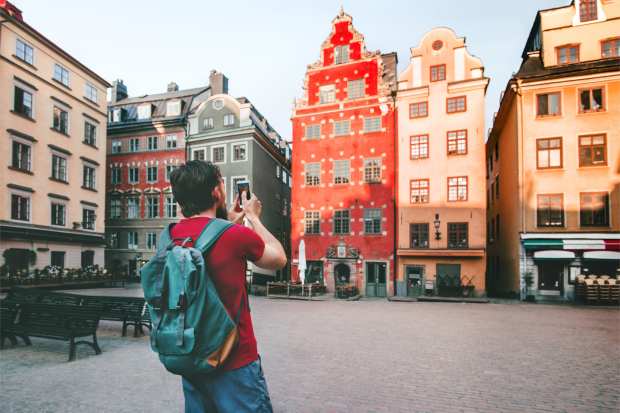Younger Travelers Take More Luxury Trips, But Have A Harder Time Paying

The travel market is changing and companies are evolving to meet consumer expectations. Once upon a time, Airbnb meant renting a cheap room in a stranger’s apartment. With the introduction of its Luxe product earlier this year, Airbnb is now offering stays in Tuscan farmhouses and villas in Bali, a marked step up from couch-surfing.
Travel companies are also placing more emphasis on experiences and adventure, which is intended to appeal to millennials who prefer experiences over things.
The latest Luxury Travel Study looks at these two segments: luxury and adventure travelers and examines the financial challenges that prevent many consumers from pursuing such trips.
Luxury travelers from the United States spent $1.1 trillion on their vacations last year. The market is projected to further expand, too, with an estimated 139 million people — more than half the nation’s adult population — planning to take luxury vacations next year.
One of the paradoxes revealed in this study is that younger travelers are the most likely to embark on some type of luxury vacation, while at the same time price was a bigger roadblock for these travelers. A majority (54.9 percent) of bridge millennials and conventional millennials (54.2 percent) took at least one luxury vacation within the past year. Nearly half (47.3 percent) of Gen Z said the same.
The luxury travel market’s growth is partly being driven by a relatively small but fast-growing cohort of consumers who take their luxury vacations with a side of adventure.
According to the Luxury Travel Study, 29.9 percent of luxury travelers indicate they went mountain climbing, hiking or camping last year — more than double the rate of other luxury travelers who say the same.
These consumers tend to be four years younger than all other travelers, with an average age of 42.3.
Luxury Travel Challenges
Roughly half (51.8 percent) of adventure travelers say they did not take a vacation last year because it was too expensive. The share of other luxury travelers who say the same is similar at 53.5 percent. Expense was by far one of the biggest hindrances. More than twice the number of adventure travelers cited expense, compared to travel being time consuming (20.1 percent) and needing pet care (26.0 percent).
The cost of luxury vacations affects Gen Z consumers in particular, with 58.5 percent saying price was a key reason they were unable to take such trips within the previous year. This age group is also considerably more likely than all others to cite planning struggles as the reason it could not take such vacations, at 27.7 percent.
Younger travelers also reported the greatest level of difficulty in obtaining the funds needed for past vacations. Gen Z are especially likely to struggle, with 24.5 percent of respondents in this age bracket noting it was “somewhat” or “very” difficult to do so, followed by millennials at 18.1 percent.
It makes sense then that splitting the bill with other luxury travelers is more common among the younger consumers who vacationed with others. Most Gen Z travelers (64.6 percent) say multiple people paid for their vacations, followed by millennials at 40.3 percent.
Innovations
Established and newer sites like Expedia and BookIt essentially allow consumers to buy travel on a layway plan, and solutions like Splitty Travel allow consumers to combine two rate plans to make one itinerary for their stays.
Solutions that provide secure payment processing capabilities, allow multiple participants to contribute to accounts, offer users automatic payment plan and more are highly appealing to the adventure travelers whose vacations cost more.
Adventure travelers express higher levels of interest in such payment solutions compared to other luxury travelers, with a total of 46.8 percent of the former saying they are “very or extremely” interested in such solutions compared to 38.1 percent of the latter.
Forty-five percent of adventure travelers believe innovative payment solutions would make it easier to pay for vacations, while nearly the same amount (42.4 percent) of other luxury travelers say the same. Convenience and lowering stress are also an attractive feature for both segments.
Younger travelers struggle to obtain vacation funds and are more likely to find it difficult to pay for such trips, making it unsurprising that those under age 55 are especially interested in innovative payment solutions. Millennials express the highest level of desire for such options, with 72.7 percent of them indicating they are either “somewhat” or “very or extremely” so. Interest in such solutions is also strong among other younger age groups, including Gen Z (71.7 percent), bridge millennials (71.1 percent) and Gen X (71.2 percent).
Future Plans
So, how would innovative payment solutions impact future travel plans? Younger travelers are more likely to say that they could take “somewhat” or “many” more luxury vacations if that was the case.
Roughly two-thirds of Gen Z (64.5 percent), millennials (53.4 percent) and bridge millennials (62.8 percent) would be influenced to take at least somewhat more luxury vacations if there was greater availability of innovative payment solutions.
This study revealed strong consumer interest in innovative payment solutions that would make it possible for multiple parties to split expenses, pay when they can, receive spending insights and make one-time and recurring payments.
